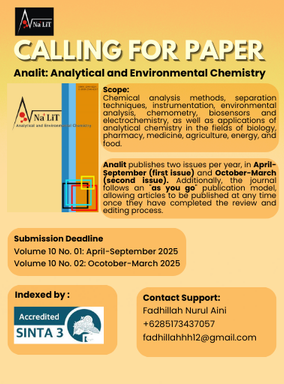Removal of remazol red dye in batik wastewater using natural coagulant of moringa seeds
DOI:
https://doi.org/10.23960/aec.v8i1.2023.p33-44Keywords:
Coagulation, Batik, Moringa seeds, Remazol redAbstract
Remazol red dye in batik wastewater can cause damage to the aquatic environment and is toxic. This study aims to reduce the concentration of remazol red dye and COD content in batik wastewater by bio-coagulation. The natural coagulant used in this study was moringa seeds. The content of coagulant functional groups in Moringa seeds was characterized using a Fourier Transform Infrared (FTIR) spectrophotometer. Biocoagulation was carried out on variations in the acidity of batik wastewater, i.e., at pH 2,3,4,5, and 6. The results of the FTIR characterization of papaya seeds after biocoagulation showed a shift in the wave numbers of the OH, N=N, and C-O groups. The optimum pH for the biocoagulation process of remazol red dye occurs at pH 4 with a % reduction of remazol red dye of 91.24 % and a decrease in COD value of 71.13 %. Keywords: remazol red, coagulation, wastewater, batik, Moringa seeds
References
Ardiyanto, M.M.F., Rahmayanti, M. (2022). Performance of ceramic membrane modified with corncob activated carbon for efficient remazol red removal in batik wastewater. Berkala Sainstek, 10(4), 202-209. https://doi.org/10.19184/bst.v10i4.34941.
Ariyatun, Ningrum, P., Musyarofah, Inayah, N. (2018). Analisis efektivitas biji dan daun kelor (Moringa oleifera) untuk penjernihan air, 1(2), Walisongo Journal of Chemistry, 1(2), 60- 65. https://doi.org/10.21580/wjc.v2i2.3103.
Bertus, M. Y. P., Suherman, Sabang, S.M. (2014). Karakterisasi FTIR poliblend adsorben serbuk biji buah kelor (Moringa Oleifera) dan cangkang ayam ras untuk pengolahan air gambut di daerah Palu Barat. Jurnal Akademika Kimia, 3(1), 21-29.
Fauzi, R.A., Rahmayanti, M. (2020). Optimasi pH dan waktu reaksi adsorpsi indigosol blue O4B menggunakan asam humat termodifikasi magnetit (HA/Fe3O4). Analit: Analytical and Environmental Chemistry, 5(2), 135-142. http://dx.doi.org/10.23960%2Faec.v5i2.2020.p135-142
Fitriana, N., Rahmayanti, M. (2020). Aplikasi membran filter keramik untuk menurunkan konsentrasi zat warna remazol red dan nilai COD limbah cair batik. Al-Kimia, 8(2), 159- 167.
Fuadah, S. R., Rahmayanti, M. (2019). Adsorpsi desorpsi zat warna naftol blue black menggunakan adsorben humin hasil isolasi tanah gambut riau, sumatera. Analit: Analytical and Environmental Chemistry, 4(2), 59-67. http://dx.doi.org/10.23960%2Faec.v4i2.2019.p59-67.
Irmayana, Hadisantoso, E.P., Isnaini, S. (2017). Pemanfaatan biji kelor (Moringa oleifera) sebagai koagulan alternatif dalam proses penjernihan limbah cair industri tekstil kulit. Jurnal Istek, 10(2), 48-61.
Kumar, M., Selvasekaran, P., Kapoor, S., Barbhai, M.D., Lorenzo, J.M., Saurabh, V., Potkule, J.,Changan, S., Kelish, A.E., SeliM, S., Sayed, A.A.S., Singh, R.S., Senapathy, M., Pandiselvam, R., Dey. A.,, Dhumal, S., Natta, S., Amarowicz, R., Kennedy, J.F. (2022). Moringa oleifera Lam. seed proteins: Extraction, preparation of protein hydrolysates, bioactivities, functional food properties, and industrial application. Food Hydrocolloids, 131, 107791. https://doi.org/10.1016/j.foodhyd.2022.107791.
Kuniawan, M.W. Purwanto, P., Sudarno, S. (2013). Strategi pengolahan air limbah sentra UMKM batik. Sukoharjo. Ilmu Lingkungan.
Núñez-Gastéluma, J.A., Arguijo-Sustaita, A.A., López-Díaza, J.A., Díaz-Sáncheza, A.G., Hernández-Peña, C.C., Cota-Ruiz, K. (2022). Seed germination and sprouts production of Moringa oleifera: A potential functional food?. Journal of the Saudi Society of Agricultural Sciences. In press.
Pembayun, S.W.R., Rahmayanti, M. (2020). Efektivitas biji asam jawa sebagai koagulan alami dalam menurunkan konsentrasi zat warna remazol red dan nilai COD. Jurnal Sains dan Teknologi. 9(2), 162-169. https://doi.org/10.23887/jstundiksha.v9i2.28171.
Rahmayanti, M., Syakina, A.N., Fatimah, I., Sulistyaningsih, T. (2022). Green synthesis of magnetite nanoparticles using peel extract of jengkol (Archidendron pauciflorum) for methylene blue adsorption from aqueous media. Chemical Physic Letter, 803, 139834.
Rahmayanti, M., Yahdiyani, A., & Afifah, I. Q. (2022). Eco-friendly synthesis of magnetite based on tea dregs (Fe3O4-TD) for methylene blue adsorbent from simulation waste. Communications in Science and Technology, 7(2), 119-126. https://doi.org/10.21924/cst.7.2.2022.965.
Rahmayanti, M., Nurhikmah, I., Larasati, F. (2021). Isolation, characterization and application of humin from Sumatran peat soils as adsorbent for naphtol blue black and indigosol blue dyes. Molekul, 1, 67–74. http://dx.doi.org/10.20884/1.jm.2021.16.1.700.
Rahmayanti, M., Prandini, M.N., Santi. G.C. (2020). Aplikasi asam humat hasil isolasi tanah gambut kalimantan sebagai adsorben zat warna naphtol blue black dan indigosol blue: Studi perbandingan model kinetika dan isoterm adsorpsi. Jurnal Sains Terapan, 6(2), 90- 98. https://doi.org/10.32487/jst.v6i2.891.
Safitri, R. A., Rahmayanti, M. (2020). Characterization and Application of Chitosan as a Natural Coagulant in Reducing Remazol Red Dyestuff Concentration and COD Value of Batik Liquid Waste. Jurnal Kimia Sains dan Aplikasi, 23(9), 333- 337. https://doi.org/10.14710/jksa.23.9.333-337.
Steven, M. (2001). Kimia Polimer. Jakarta. Erlangga. Tatoba, Kurade, Kabra, dan Govindwar. 2012. Degradation of Remazol Red Dye by Galactomyces Geotrichum MTCC 1360 Leading to Increased Iron Uptake in Sorghum Vulgare and Phaseolus mungo from Soil. Journal Biotechnology and Bioprocess Engineering.
Downloads
Published
Issue
Section
License
Copyright (c) 2024 Ulfa Arisca Yuniawati, Maya Rahmayanti

This work is licensed under a Creative Commons Attribution-ShareAlike 4.0 International License.
- Authors retain copyright and acknowledge that the Analit : Analytical and Environmental Chemistry is the first publisher, licensed under a Creative Commons Attribution 4.0 International License.
- Authors are able to enter into separate, additional contractual arrangements for the non-exclusive distribution of the journal's published version of the work (e.g., post it to an institutional repository or publish it in a book), with an acknowledgment of its initial publication in this journal.
- Authors are permitted and encouraged to post their work online (e.g., in institutional repositories or on their website) prior to and during the submission process, as it can lead to productive exchanges and earlier and greater citation of published work.





